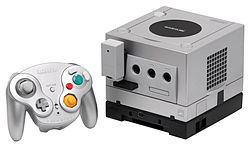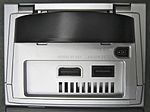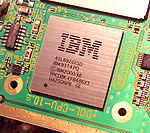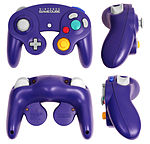- Nintendo GameCube
-
Nintendo GameCube 
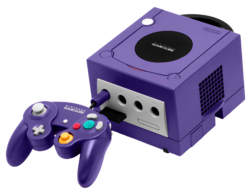
Indigo GameCube and controllerManufacturer Nintendo Generation Sixth generation Retail availability Discontinued February 22, 2007[1] Units sold Worldwide: 21.74 million
Japan: 4.04 million
North America: 12.94 million
Europe & Australia: 4.77 million[2]Media Nintendo GameCube game disc CPU IBM PowerPC "Gekko", 486 MHz Storage capacity Nintendo GameCube Memory Card (16 MB max. capacity) Display - Composite video
- S-Video (NTSC consoles only)
- RGB SCART (PAL consoles only)
- YPBPR Component video / D-Terminal (DOL-001 models only)*
Graphics ATI "Flipper", 162 MHz Sound Analog stereo (support for Dolby Pro Logic II) Input Nintendo GameCube controller, WaveBird, Game Boy Advance, numerous other input devices Connectivity Nintendo GameCube Broadband Adapter and Modem Adapter Dimensions 5.9 × 6.3 × 4.3 in
149 × 193 × 112 mm
(width × depth × height)Best-selling game Super Smash Bros. Melee, 7.09 million (as of March 10, 2008)[3] Predecessor Nintendo 64 Successor Wii The Nintendo GameCube (ニンテンドーゲームキューブ Nintendō Gēmukyūbu), officially abbreviated to NGC in Japan[4][5] and GCN in other regions,[6] was Nintendo's fourth home video game console and was part of the sixth generation console era. It was the successor to the Nintendo 64 and predecessor to the Wii.
The Nintendo GameCube was the first Nintendo console to use optical discs as its primary storage medium, after several aborted projects from Nintendo and its partners to utilize optical-based storage media.[citation needed] In contrast with the GameCube's contemporary competitors, Sony's PlayStation 2, Sega's Dreamcast and Microsoft's Xbox, the GameCube uses miniDVD-based discs instead of full-size DVDs. Partially as a result of this, it does not have the DVD-Video playback functionality of these systems, nor the audio CD playback ability of other consoles that use full-size optical discs.
In addition, the GameCube introduced a variety of connectivity options to Nintendo consoles, and was the fourth Nintendo console, after the Nintendo 64DD, Famicom Modem and Satellaview, to support online play officially, via the Nintendo GameCube Broadband Adapter and Modem Adapter (sold separately). It also enabled connectivity to the Game Boy Advance to access exclusive features of certain games or to use the portable system as a controller for the Game Boy Player.
The console was released on September 15, 2001 in Japan, November 18, 2001 in North America, May 3, 2002 in Europe, and May 17, 2002 in Australia. The GameCube sold 21.74 million units worldwide. Panasonic also released a DVD player hybrid of the console, the Panasonic Q, which was only released in Japan.[2]
Contents
Marketing
Nintendo used several advertising strategies and techniques for the GameCube. Around the time of release, the GameCube was advertised with the slogan "Born to Play."[7] The earliest commercials displayed a rotating cube animation, which would morph into the GameCube logo as a female voice whispers, "GameCube". This was usually displayed at the end of GameCube game commercials.[8]
A subsequent ad campaign featured the "Who Are You?" slogan across Nintendo's entire product line, to market the wide range of games Nintendo offers. The idea behind the "Who Are You?" campaign was that "you are what you play"; the kind of game a person enjoys playing suggests something about that gamer's personality. The "Who Are You?" logo was designed in graffiti-style lettering. Most of the "Who Are You?" commercials advertised games developed or published by Nintendo, but some developers paid Nintendo to promote their games, using Nintendo's marketing and advertising resources.
Hardware
Like its predecessor, the Nintendo 64, the Nintendo GameCube was available in many colors. The two most common, released during the console's launch, were "Indigo" (the standard color used in most early advertising) and "Jet Black." "Spice" (orange) GameCubes were also offered as standard models, but only in Japan. However, the standard controller was widely available in this color outside of Japan as well. Later, Nintendo released GameCubes with a "Platinum" (silver) color scheme, initially marketed as a limited edition product. Other limited edition colors and styles were also only released in Japan.
Following Nintendo tradition, the GameCube's model numbers, DOL-001 and 101, are a reference to its codename, "Dolphin."[9] The official accessories and peripherals have model numbers beginning with DOL as well. Another Dolphin reference, "Flipper" was the name of the GPU for the GameCube.[10] Panasonic made a licensed version of the GameCube with DVD playback, called the Panasonic Q.
Benchmarks provided by third-party testing facilities indicate that Nintendo's official specifications, especially those relating to performance, may be conservative. One of Nintendo's primary objectives in designing the GameCube hardware was to overcome the perceived limitations and difficulties of programming for the Nintendo 64 architecture, thus creating an affordable, well-balanced, developer-friendly console that still performed competitively against its rivals.[11]
The development hardware kit was called the GameCube NR Reader. Model numbers for these units begin with DOT. These units allow developers to debug beta versions of games and hardware. These units were sold to developers by Nintendo at a premium price and many developers modified regular GameCubes for game beta testing because of this. The NR reader will not play regular GameCube games, only special NR discs burned by a Nintendo NR writer.[citation needed]
Technical specifications
The Nintendo GameCube Game Disc was the software storage medium for the Nintendo GameCube, created by Matsushita. Chosen to prevent unauthorized copying and to avoid licensing fees to the DVD Consortium, it was Nintendo's first non-cartridge storage method for consoles released outside of Japan (the Famicom Disk System and Nintendo 64DD were exclusive to Japan). Some games which contain large amounts of voice acting or pre-rendered video (for example, Tales of Symphonia) have been released on two discs; however, only twenty-five games have been released on two discs, and none require more than two discs.
The MultiAV port was identical to the one used in Nintendo's earlier Super Nintendo Entertainment System and Nintendo 64 consoles, allowing most cables from these systems to be used interchangeably.
Nintendo found that the Digital AV port was used by less than one percent of users, leading to the removal of the port from consoles with model number DOL-101 manufactured after May 2004.[12]
Serial Port 2 was also removed from models manufactured after the first product revision.
All Nintendo GameCube systems support the display of stereoscopic 3D, however this was only ever utilised for the launch title Luigi's Mansion, and the feature was never enabled outside of development.[13] 3D televisions were not widespread at the time, and it was deemed that compatible displays would be too cost-prohibitive for the consumer.[13]
Central processing unit:
Main article: Gekko (microprocessor)- 486 MHz IBM "Gekko" PowerPC CPU
- PowerPC 750CXe-based core[14]
- 180 nm IBM copper-wire process, 43 mm² die, 4.9 W dissipation[14]
- Roughly fifty new vector instructions[14]
- 32-bit ALU
- 64-bit FPU (1.9 GFLOPS, usable as 2 × 32-bit SIMD)[14]
- 64-bit enhanced PowerPC 60x front side bus to GPU/chipset, 162 MHz clock, 1.3 GB/s peak bandwidth[14]
- 64 kB (32 kB I/32 kB D) L1 cache (8-way associative), 256 kB on-die L2 cache (2-way associative)[14]
- 1125 DMIPS (dhrystone 2.1)
System memory:
- 43 MB total non-unified RAM
- 24 MB MoSys 1T-SRAM (codenamed "Splash") main system RAM, 324 MHz, 64-bit bus, 2.7 GB/s bandwidth[14]
- 3 MB embedded 1T-SRAM within "Flipper"[15]
- Split into 1 MB texture buffer and 2 MB framebuffer[15]
- 10.4 GB/s texture peak bandwidth, 7.6 GB/s framebuffer peak bandwidth, ≈ 6.2 ns latency[14]
- 16 MB DRAM used as buffer for DVD drive and audio, 81 MHz, 8-bit bus, 81 MB/s bandwidth[14]
Connectivity:
- 4 controller ports, 2 memory card slots
- Analog AV Out: interlaced composite video, S-Video (NTSC models only), and RGB SCART (PAL models only), stereophonic analog audio
- Digital AV Out (DOL-001 only): interlaced or progressive scan YCBCR video, decoded to YPBPR using a DAC chip inside component video and D-Terminal cables,[16] stereophonic I²S audio (never officially utilized)
- Resolutions: 480i, 576i, 480p
- High-speed serial ports: 2
- Serial Port 1 is reserved for a broadband adapter or modem adapter
- Serial Port 2 is unused
- High-speed parallel ports: 1 (reserved for the Game Boy Player)
- Power supply output: 12 volts DC; 3.25 amperes
- Physical Measurements: 150 × 161 × 110 mm / 5.9 × 6.3 × 4.3 in (width × depth × height)
Graphics processing unit:
- 162 MHz "Flipper" LSI (co-developed by Nintendo and ArtX, acquired by ATI)
- 180 nm NEC eDRAM-compatible process
- 8 GFLOPS
- 4 pixel pipelines with 1 texture unit each[14]
- TEV "Texture EnVironment" engine (similar to Nvidia's GeForce-class "register combiners")
- Fixed-function hardware transform and lighting (T&L), 20+ million polygons in-game[17]
- 648 megapixels/second (162 MHz × 4 pipelines), 648 megatexels/second (648 MP × 1 texture unit) (peak)
- Peak triangle performance: 20,250,000 32-pixel triangles/s raw and with 1 texture and lit
- 337,500 triangles a frame at 60 FPS
- 675,000 triangles a frame at 30 FPS
- Peak triangle performance: 20,250,000 32-pixel triangles/s raw and with 1 texture and lit
- 8 texture layers per pass, texture compression, full scene anti-aliasing[17]
- 8 simultaneous hardware light sources
- Bilinear, trilinear, and anisotropic texture filtering
- Multi-texturing, bump mapping, reflection mapping, 24-bit z-buffer
- 24-bit RGB/32-bit RGBA color depth
- Hardware limitations sometimes require a 6r+6g+6b+6a mode (18-bit color), resulting in color banding.
Video Modes:
- 640×240 interlaced (240i) or progressive scan (240p) - 60 Hz[18]
- 640×480 interlaced (480i) or progressive scan (480p) - 60 Hz
- 640×576 interlaced (576i) - 50 Hz
Audio:
- Integrated audio processor: Custom 81 MHz Macronix DSP
Storage media:
For more details on this topic, see Nintendo optical discs.- Panasonic-developed CAV miniDVD-like 8 cm optical disc, 2.000 MB/s–3.125 MB/s transfer rate, 128 ms average access time, 1.5 GB capacity
- Memory cards of varying sizes for saved game storage
Memory and storage
The GameCube features two ports that accommodate memory cards for saving game data. The three official memory card sizes are: 59 blocks (4 Mbit/512 KB, gray card), 251 blocks (16 Mbit/2 MB, black), and 1019 blocks (64 Mbit/8 MB, white). Cheaper third-party memory cards are also available.[19]
Controller
Main articles: Nintendo GameCube controller and WaveBird Wireless ControllerThe standard GameCube controller has a wing grip design, and was designed to fit well in the player's hands. It includes a total of eight buttons, two analog sticks, a D-pad, and an internal rumble motor. The primary analog stick was on the left, with the D-pad below it. On the right are four buttons; a large green "A" button in the center, a smaller red "B" button to the left, an "X" button to the right and a "Y" button to the top. Below those, there was a yellow "C" stick, which often serves different functions, such as controlling the camera. The Start/Pause button was located at the middle of the controller face, and the rumble motor was encased within the center of the controller.
On the top of the controller there are two analog shoulder buttons marked "L" and "R," as well as one digital button marked "Z." The "L" and "R" shoulder buttons feature both analog and digital capabilities. Each of these buttons behaves as a typical analog button until fully depressed, at which point the button "clicks" to register an additional digital signal. This method effectively serves to provide two functions per button without actually adding two separate physical buttons.
The WaveBird Wireless Controller was an RF-based wireless controller, based on the same design as the standard controller. This controller comes in light grey and platinum. It communicates with the GameCube system wirelessly through a receiver dongle connected to one of the system's controller ports. It was powered by two AA batteries. As a power-conservation measure, the WaveBird lacks the rumble function of the standard controller.
Technical issues
Some launch GameCube consoles developed disc read problems with the optical pickup becoming thermally sensitive over time, causing read errors when the console reached normal operating temperature. Failures of this sort require replacement of the optical pickup. Affected consoles have sometimes been serviced free of charge by Nintendo even after the expiration of the warranty period.[20]
Software library
See also: List of Nintendo GameCube games, List of Nintendo GameCube games with 480p and 16:9 support, Chronology of GameCube games, and Player's ChoiceLaunch games
The GameCube launched in North America with the following twelve games:
Title Developer Publisher(s) All-Star Baseball 2002 Acclaim Acclaim Batman Vengeance Ubisoft Ubisoft Crazy Taxi Hitmaker Sega Dave Mirra Freestyle BMX 2 Z-Axis Acclaim Disney's Tarzan Untamed Ubisoft Ubisoft Luigi's Mansion Nintendo Nintendo Madden NFL 2002 EA Tiburon EA Sports NHL Hitz 20-02 EA Black Box Midway Star Wars Rogue Squadron II: Rogue Leader Factor 5 LucasArts Super Monkey Ball Amusement Vision Sega Tony Hawk's Pro Skater 3 Neversoft Activision Wave Race: Blue Storm NST Nintendo One of the defining aspects of the Nintendo GameCube was the rejuvenated relationship between Nintendo and its licensees. Unlike previous generations in which Nintendo was accused of taking advantage of its leadership role in the video game marketplace by posing monopolistic restrictions on its third-party game developers that vastly favored Nintendo, the company openly sought game-development aid on the Nintendo GameCube.[citation needed] Sometimes, Nintendo would merely request that a third-party developer produce a game based on the third-party's own game franchises; other times, Nintendo would request that the third-party developer produce a game based on Nintendo's own game franchises. In both cases, Nintendo often took an active role in cooperating with the developer.[citation needed] This policy on Nintendo's part resulted in exclusive third-party games for the Nintendo GameCube, and the arrival of multi-format games for the console.
Despite Nintendo's efforts, the GameCube failed to reclaim the market share lost by its predecessor, the Nintendo 64. In terms of overall hardware sales, it remained a steady third place behind its direct competitors - Sony's PlayStation 2 and Microsoft's Xbox - throughout the lifespan of all three consoles. The console's "family-friendly" appeal and lack of support from certain third-party developers skewed the GameCube toward a younger market, which was a minority demographic of the gaming population during the sixth generation (see chart). Many third-party games popular with teenagers or adults, such as the blockbuster Grand Theft Auto series and several key first-person shooters, skipped the GameCube entirely in favor of the PlayStation 2 and Xbox.
While many of Nintendo's own first-party titles saw strong sales, this did not typically benefit third-party developers or drive sales of their games. Many cross-platform games — such as sports franchises released by Electronic Arts — sold far below their PlayStation 2 and Xbox counterparts, eventually prompting some developers to scale back or completely cease support for the GameCube. After several years of losing money from developing for Nintendo's console, Eidos Interactive announced in September 2003 that it would end support for the GameCube, canceling several games that were in development.[21] Later, however, Eidos resumed development[22] of GameCube titles, releasing hit games such as Lego Star Wars: The Video Game and Tomb Raider: Legend. In addition, several third-party games originally intended to be GameCube exclusive - most notably Resident Evil 4 - were eventually ported to other systems in an attempt to maximize profit following lackluster sales of the GameCube originals.
The 1.5 GB proprietary disc format may also have been a limiting factor since the PlayStation 2 and Xbox could use 8.5 GB Dual-Layer DVDs for larger games. The GameCube disc still had sufficient room for most games, although a few would require an extra disc or, less often, feature less content than the other versions. Higher video compression for some games was also potentially more apparent on some GameCube versions, if employed by developers as a workaround for storage constraints.
Also, due to Nintendo's lack of support for the online capabilities of the GameCube (as compared to Sega, Sony, and Microsoft, who actively promoted online gaming by releasing first-party online titles and soliciting developers for support), multi-platform games with online functionality were released offline-only on the GameCube. Although online support was added in late 2002 and both Sony and Nintendo followed a similar decentralized online model (in contrast to the centralized Xbox Live), lower sales of the GameCube versions of games during its launch year precluded developers from including online support.
Due to sagging sales, Nintendo halted GameCube production for a brief period in 2003 in order to reduce surplus units.[23] Sales rebounded slightly after a price drop to US$99 on September 24, 2003[24] and the release of The Legend of Zelda: Collector's Edition bundle. A demo disc, the Nintendo GameCube Preview Disc, was also released in a bundle in 2003.[citation needed] Beginning with this period, GameCube sales continued to be steady, particularly in Japan,[citation needed] but the GameCube remained in third place in worldwide sales during the sixth generation era due to weaker sales performance elsewhere.
Some third-party companies, such as Ubisoft, THQ, Disney Interactive Studios, Humongous Entertainment and EA Sports, continued to release GameCube games well into 2007.[25][26][27][28] These titles include TMNT, Meet the Robinsons, Surf's Up, Ratatouille and Madden NFL 08.[citation needed]
Online gaming
The GameCube was at one point online compatible by using a GameCube Broadband Adapter or Modem Adapter, though only four games featured an online component which were Homeland, Phantasy Star Online Episode I & II, Phantasy Star Online Episode I & II Plus and Phantasy Star Online Episode III: C.A.R.D. Revolution. This online play was ended as of April 2007. Although the official servers for the PSO titles are now offline, it is still possible to play online on various private servers such as SCHTHACK. LAN gameplay is still available for the three titles that originally supported it as well: Mario Kart: Double Dash‼, 1080° Avalanche and Kirby Air Ride. There are some third-party PC applications such as Warp Pipe and XLink Kai that allows online play of these three games by tunneling the network traffic through a computer and across the Internet, though this is not supported by Nintendo.
Reception and sales
Although generally receiving positive comments on its software library which includes some of the highest-rated video games ever made, the GameCube received criticism for its "toy-ish" external hardware design and for lacking some of the technical features of its competitors (such as DVD playback, digital audio output, widespread online support, and widescreen display mode for most games).[29]
The GameCube sold nearly 22 million units worldwide during its lifetime,[2] lagging far behind the PlayStation 2's almost 154 million.[30][31] The GameCube finished its generation slightly behind the Xbox, which sold 24 million units before being discontinued, and well ahead of the short-lived Dreamcast, which sold 10.6 million. The GameCube failed to outsell its predecessor, the Nintendo 64, which sold almost 33 million units in its lifetime.[32]
In September 2009, IGN named the GameCube the 16th best gaming console of all time, behind all three of its competitors: the PlayStation 2 (3rd), Dreamcast (8th), and Xbox (11th). Aside from the Virtual Boy (which did not make the list at all), it was the only Nintendo console to not make the list's top 10.[29]
Games
See also: List of best-selling Nintendo GameCube video gamesThe number of games released for the console exceeds 600, with 208.56 million GameCube games sold as of June 30, 2008.
See also
References
- ^ "Nintendo ends GameCube support". Market for Home Computing and Video Games. February 22, 2007. http://www.mcvuk.com/news/25794/Nintendo-cuts-GameCube-support. Retrieved January 16, 2011.
- ^ a b c "Consolidated Sales Transition by Region" (PDF). Nintendo. June 2011. Archived from the original on 2011-07-28. http://www.webcitation.org/60VrBE6Cp. Retrieved September 4, 2011.
- ^ "At Long Last, Nintendo Proclaims: Let the Brawls Begin on Wii!" (Press release). Nintendo. March 10, 2008. http://www.nintendo.com/whatsnew/detail/1u0FthaPxTSSeJelWm4Jt8TI0VJlTt5j. Retrieved March 11, 2008. "The previous installment in the series, Super Smash Bros. Melee, was the best-selling game for Nintendo GameCube with 7.09 million copies sold worldwide."
- ^ "ニンテンドー ゲームキューブ". Nintendo Co., Ltd.. http://www.nintendo.co.jp/ngc/. Retrieved June 18, 2010.
- ^ "First Quarter Financial Results Briefing Q & A". Investor Relations. Nintendo Co., Ltd.. July 31, 2009. http://www.nintendo.co.jp/ir/en/library/events/090731qa/index.html. Retrieved June 18, 2010.
- ^ "support.nintendo.com". Nintendo of America. http://www.nintendo.com/consumer/systems/nintendogamecube/trouble_sound.jsp. Retrieved April 23, 2011.
- ^ "GameCube Slogan Revealed!". Nintendo World Report. September 3, 2001. http://www.nintendoworldreport.com/news/6408. Retrieved October 25, 2009.
- ^ "Kirby Air Ride". GameTrailers. http://www.gametrailers.com/video/tv-spot-kirby-air/1831. Retrieved March 27, 2008.
- ^ "Say Hello to Project Dolphin". IGN. 1999-05-04. http://cube.ign.com/articles/067/067938p1.html. Retrieved 2008-01-27.
- ^ "GameCube 101: Graphics". IGN. 2001-01-16. http://cube.ign.com/articles/090/090003p1.html. Retrieved 2008-01-27.
- ^ Satterfield, Shane. "GameCube Dossier". GameSpot. http://www.gamespot.com/gamespot/features/video/gamecube_dossier/. Retrieved 2008-03-27.
- ^ "Nintendo's GameCube Component FAQ page". Nintendo. http://www.nintendo.com/consumer/systems/nintendogamecube/component_faq.jsp. Retrieved 2008-03-27.
- ^ a b "Iwata Asks: Nintendo 3DS". p. 3. http://www.nintendo.co.uk/NOE/en_GB/news/iwata/iwata_asks_-_nintendo_3ds_30756_30757.html#top. Retrieved 2011-01-11. "Iwata: To go back a little further, the Nintendo GameCube system actually had 3D-compatible circuitry built in [...] Itoi: Nintendo GameCube did? And all the Nintendo GameCube systems around the world? Iwata: Yeah. If you fit it with a certain accessory, it could display 3D images."
- ^ a b c d e f g h i j "Game Consoles: A Look Ahead". Ace's Hardware. 2003-12-14. Archived from the original on 2004-02-08. http://web.archive.org/web/20040208044032/http://www.aceshardware.com/read.jsp?id=60000288. Retrieved 2008-03-27.
- ^ a b "GCN Technical Specifications". Nintendo. Archived from the original on 2008-05-02. http://web.archive.org/web/20080502201300/http://register.nintendo.com/techspecgcn. Retrieved 2008-03-28.
- ^ "Nintendo GameCube Digital AV Connector". GameSX]. http://gamesx.com/wiki/doku.php?id=av:nintendodigitalav. Retrieved 2011-06-26.
- ^ a b c "DCTP — Nintendo's Gamecube Technical Overview". Segatech. Archived from the original on 2008-02-22. http://web.archive.org/web/20080222190252/http://www.segatech.com/gamecube/overview/index.html. Retrieved 2008-03-27.
- ^ "GameCube SDK - Video Interface Library (VI)" (PDF). p. 10. http://www.djek.nl/Downloads/GC/DOCS/GRAPPRO/VI.us.pdf. Retrieved 2011-06-27.
- ^ "Nintendo GameCube Accessories". Nintendo. http://www.nintendo.co.uk/NOE/en_GB/systems/accessories_1222.html. Retrieved 2009-07-03.
- ^ "Nintendo GameCube Error Messages". Nintendo. http://www.nintendo.com/consumer/systems/nintendogamecube/trouble_errormessages.jsp. Retrieved 2008-03-27.
- ^ "Eidos to Pull GCN Support". IGN. 2003-09-05. http://cube.ign.com/articles/436/436915p1.html. Retrieved 2007-07-12.
- ^ "Game Companies: Eidos Interactive". GameFAQs. http://www.gamefaqs.com/features/company/1828.html. Retrieved 2007-07-12.
- ^ "Nintendo revives GameCube production". GameSpot. 2003-11-05. http://www.gamespot.com/news/6078214.html. Retrieved 2009-10-27.
- ^ "Nintendo GameCube Price Drops to $99!". Nintendo. 2003-09-24. http://www.businesswire.com/news/home/20030924005222/en/Nintendo-GameCube-Price-Drops-99!-Hardware-Price. Retrieved 2007-07-13.
- ^ "Surf's Up official Press Release". Ubisoft. 2007-04-19. http://www.ubi.com/ENCA/News/Info.aspx?nId=4469. Retrieved 2007-04-18.
- ^ "Ratatouille official Press Release". THQ. 2006-11-06. http://investor.thq.com/phoenix.zhtml?c=96376&p=irol-newsArticle&ID=927018&highlight=. Retrieved 2007-04-18.
- ^ "Madden NFL 08 official Press Release". Electronic Arts. 2007-04-18. Archived from the original on 2007-12-29. http://web.archive.org/web/20071229050750/http://www.ea.com/article.jsp?id=madden08pressrelease. Retrieved 2007-04-18.
- ^ "Disney Showcases E3 Lineup". Nintendo World Report. 2007-08-02. http://www.nintendoworldreport.com/pr/13940. Retrieved 2007-04-18.
- ^ a b "Nintendo GameCube is number 16". IGN Entertainment. http://www.ign.com/top-25-consoles/16.html. Retrieved 15-Oct-2009.
- ^ "SONY COMPUTER ENTERTAINMENT ASIA STARTS ITS PLAYSTATION® BUSINESS IN REPUBLIC OF INDONESIA". SCEI. 2010-01-08. http://www.scei.co.jp/corporate/release/100118e.html. Retrieved 2010-02-13.
- ^ "PlayStation®2 Worldwide Hardware Unit Sales". SCEI. 2010-04-01. http://www.scei.co.jp/corporate/data/bizdataps2_sale_e.html. Retrieved 2010-05-16.
- ^ "All Time Top 20 Best Selling Games". 2003-05-21. Archived from the original on 2006-02-21. http://web.archive.org/web/20060221044930/http://www.ownt.com/qtakes/2003/gamestats/gamestats.shtm. Retrieved 2008-03-27.
External links
- Nintendo GameCube Official webpage by Nintendo of America
- Nintendo GameCube at Nintendo.com (archived versions at the Internet Archive Wayback Machine)
- GameCube at the Open Directory Project
- A sortable list of all games to Gamecube
Sixth generation video game consoles 5th generation7th generationCategories:- Nintendo GameCube
- Products introduced in 2001
- Power Architecture
- Sixth-generation video game consoles
- 2007 disestablishments
- Toys of the 2000s
- Nintendo hardware
Wikimedia Foundation. 2010.

